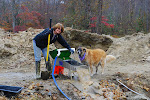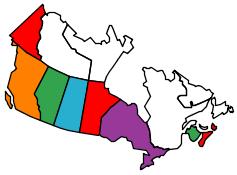There was no Gilligan, no Mary Ann, no Professor or Howells, but there was a Skipper who knew pretty much and was good at finding wildlife on this 6 hour tour around the Kenai Fjord, Resurrection Bay, and Aialik Glacier, part of the Harding Ice Field- the largest ice field in North America. Aside from a few notes, this will be primarily a photo post. The weather was perfect. The sea was calm. And we saw almost everything that was possible to see.


A convention of the endangered Qaiguaq harbor seals was one of the first animal groups we came upon.

There were puffins, hundreds of them, everywhere, both horned and tufted.

Murres are the closet thing the northern hemisphere has to penguins. They look like them, they walk and swim like them. They sound like them, and actually, they pretty much smell like them! I had never seen them in the wild before.

Love the roar of the Steller Sea Lions...

Animals on the check list but not pictured here: Cormorants and dozens of other bird species, bald eagles, sea otters, Dall's porpoise, and much more.

It wound up being a great day for whales. We saw several humpbacks, a couple fin whales, and an entire group of Orcas or Killer Whales. We got lots and lots, and I do mean lots, of fluke shots, some rolling, some breaching, some blowing and some spyhops (where the whale pushes his head out of the water to survey the surrounding environment).

Click on the photo below to enlarge to get a first hand look at the color pattern of this fluke. Whales are identified by these patterns- they are much like finger prints are to humans. The Skipper knew some of these whales by name or number- or both.

In the next several shots, you can see a mother humpback whale teaching her calf some life lessons. She signaled non stop for over 20 minutes with her tale in the air while the calf imitated her tale waving and slapping, breached, rolled, and spy hopped up to check us out. It was a most amazing display and a rare opportunity.




Below, the sail like fin of the male Orca...

A pair of Orcas play near our cruise boat.

The rest of the shots are of the Aialik Glacier. It is truly amazing, but driving the boat nearly right up to it does not give you the true sense of the glacier. The glacier is a mile across where it meets the see. It is a half mile deep (thick) in places, but a mere 300 feet tall where it faces the sea. Our boat pulled to within 1/4 mile of the face- to allow for escape if too large a calf were to fall, creating too large a wave for the boat to handle. Even at the 1/4 mile distance, large pieces of ice falling off the face of the glacier (or calving) looked small. That is of course until you heard them hit the water below in what can only be described as a canon shot going off nearby. When the larger pieces calved, the roar was deafening. And even when the ice was not falling visibly, the creaking and cracking and slipping and sliding of the glacier sounded like we were in the midst of a tremendous thunder storm. With the boat engines off for a short time, the sound of the glacier was even more impressive than the sight of it- if that is possible- and we all fell silent aboard the ship in shear amazement. It was, perhaps, the most amazing single sight we have seen so far on the trip.






 And speaking of sand bars, how about the Salty Dawg? Perhaps the most famous bar in Alaska and known all over the world, we paid it a visit and took a tour. It’s small; a tour takes about as long as a tour of our motor coach, and I think the square footage must be about the same. But sometimes good things come in small packages and this must be the case. We thought maybe we would stop in for a brewski (Russian influence in the area you know) but it was so crowded and so smoky, that we just took a couple pics for the record and moved on. Of special note, the dollar signs! No not these: $$$$$. The ones that are made of dollar bills with the name and address of any patrons who care to pin one on the wall- not that there is any room left to do so any longer.
And speaking of sand bars, how about the Salty Dawg? Perhaps the most famous bar in Alaska and known all over the world, we paid it a visit and took a tour. It’s small; a tour takes about as long as a tour of our motor coach, and I think the square footage must be about the same. But sometimes good things come in small packages and this must be the case. We thought maybe we would stop in for a brewski (Russian influence in the area you know) but it was so crowded and so smoky, that we just took a couple pics for the record and moved on. Of special note, the dollar signs! No not these: $$$$$. The ones that are made of dollar bills with the name and address of any patrons who care to pin one on the wall- not that there is any room left to do so any longer.
 Homer is the halibut capitol of the world. They do pretty well with salmon as well. And Seldovia across the bay was once the herring capitol of the world, and in fact the name of the town is a Russian word for fish (herring implied). With all that fish, and all those fish cleaning stations around town, the bald eagles are pretty much everywhere. They are birds of prey and not scavengers, but we have seen they are not averse to snacking on fish guts (or a nice fillet or two) when they are offered.
Homer is the halibut capitol of the world. They do pretty well with salmon as well. And Seldovia across the bay was once the herring capitol of the world, and in fact the name of the town is a Russian word for fish (herring implied). With all that fish, and all those fish cleaning stations around town, the bald eagles are pretty much everywhere. They are birds of prey and not scavengers, but we have seen they are not averse to snacking on fish guts (or a nice fillet or two) when they are offered. "Baldy" air controller at the airport.
"Baldy" air controller at the airport. Salmon “on the spit”? The first two silvers (Cohos) go into the log book and subsequently onto the grill. Yum!
Salmon “on the spit”? The first two silvers (Cohos) go into the log book and subsequently onto the grill. Yum! As part of getting to know the area, we made a day cruise to Seldovia. Not accessible by road (only by sea and partly by rail now) it was once the hub of this part of Alaska. Today it is a picturesque sleepy little fishing village of 300 people (and a few old grumps according to their brochure). The village is built on a “boardwalk” which makes it different for Alaska, but a lot like many parts of Maine. We thought it had the distinct feel of Boothbay Harbor, which felt kind of like home to us. We’ve had many a good time with friends in Boothbay.
As part of getting to know the area, we made a day cruise to Seldovia. Not accessible by road (only by sea and partly by rail now) it was once the hub of this part of Alaska. Today it is a picturesque sleepy little fishing village of 300 people (and a few old grumps according to their brochure). The village is built on a “boardwalk” which makes it different for Alaska, but a lot like many parts of Maine. We thought it had the distinct feel of Boothbay Harbor, which felt kind of like home to us. We’ve had many a good time with friends in Boothbay.

 Like everywhere we have been in Alaska, the vehicles have cracked windshields, dogs in passenger seats, and a camper incorporated one way or the other.
Like everywhere we have been in Alaska, the vehicles have cracked windshields, dogs in passenger seats, and a camper incorporated one way or the other. The Russian Orthodox church looks over the village and was an interesting little building.
The Russian Orthodox church looks over the village and was an interesting little building. The boat ride to and from Seldovia was a great part of the day. In Germany they have the Autobahn highway. But the ride to Seldovia is more like the “Otterbahn” as rafts of 50 or more otters could be spotted along the way and singles popped up absolutely everywhere. Most of the females had pups riding on their bellies- and while they are adorable and highly photogenic, I found it darn near impossible to get close enough with my camera for a high quality shot.
The boat ride to and from Seldovia was a great part of the day. In Germany they have the Autobahn highway. But the ride to Seldovia is more like the “Otterbahn” as rafts of 50 or more otters could be spotted along the way and singles popped up absolutely everywhere. Most of the females had pups riding on their bellies- and while they are adorable and highly photogenic, I found it darn near impossible to get close enough with my camera for a high quality shot.
 Here’s Elephant Rock. When you first see it the elephant is drinking. But as you get closer and pass on by, the elephant lifts his trunk in an apparent wave to visitors. Cool!
Here’s Elephant Rock. When you first see it the elephant is drinking. But as you get closer and pass on by, the elephant lifts his trunk in an apparent wave to visitors. Cool!

















































